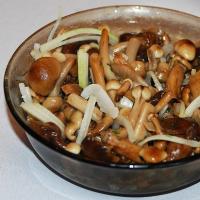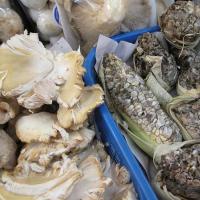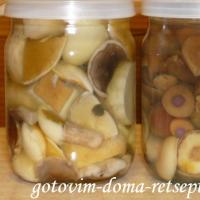We go for mushrooms in winter. Photo, description and useful properties of winter mushrooms
Few people know that a mushroom grows in our forests in winter, which contains a large amount of vitamins and useful minerals, as well as substances that activate the work of T-lymphocytes (the so-called T-killers).
In the People's Republic of China (China), this fungus is used to prevent diseases of the liver and stomach, and Japanese scientists in the course of laboratory experiments found that this fungus can be used as a prophylactic agent for oncological diseases.
In addition, this winter mushroom contains a large amount of vitamins B, C, D and amino acids, which help improve mental activity. Also, the use of this mushroom in food helps to remove toxins and heavy metals from the body.
It is hard to imagine, but this mushroom grows in our country both in the north of the country and in the middle lane. And it grows only in winter, exclusively from October to March. We can safely say that this is the most valuable gift that a winter forest can give a person. And they call this mushroom “winter mushroom”, or flammulina.
Due to their high taste and medicinal properties in Japan, Korea and China, winter mushrooms are grown on special farms in thousands of tons a year! Moreover, the cost of a kilogram of these mushrooms can reach up to 1000 rubles! But you can also collect it yourself by going for a walk in the winter forest. The main thing is to know where to look for it. Below we will see a photo of this mushroom.
For mushrooms on skis
It is difficult to confuse Flammulina velvety with any other, since this is the only mushroom that grows in our country during the winter months. It looks like ordinary mushrooms - it also grows on stumps and trees in large bushes. In the winter forest, a yellow-brownish or yellow-orange hat is visible from afar. The hat of young mushrooms is bell-shaped, while the old ones are flatter, see photo:

Its diameter can reach 8 cm. The lower part of the hat is in the form of plates, the color of which can vary from honey to cream, depending on which tree this fungus grows on. The upper part is a little slippery, it can shine in the cold.
Of course, you will not always notice these mushrooms, very often they are sprinkled with snow. Then you need to look for no less bright legs of winter mushrooms. They are very thin, up to 1 cm thick, up to 6 cm high. The flesh of the leg of an adult frammulin is very tough, so it is recommended to cut off only the upper third of the leg. The leg of young flammulins is softer, so it can be eaten all over. It is velvety to the touch, dark brown in color, but near the cap is somewhat lighter.

Usually they begin to grow at a temperature of about 0 0 C. The most interesting thing is that even during severe frosts, the body of the fungus does not die, but simply freezes and stops its growth for an indefinite time. Then, when it gets warmer, it thaws and starts growing again.
Winter honey agaric prefers to grow on deciduous trees, very rarely settles on conifers. You can also find it on old, rotten stumps. Sometimes you can find it on a tree trunk at a height of several meters! In general, it grows where its spores fall.
It is known, however, that the mushroom mycelium has a destructive effect on the tree on which it settled. Honey mushrooms, as they say, suck out all the juices, and after a few years the tree dies.

This fungus can be found on different trees, but first of all, you should pay attention to poplars, aspens, birches. It can also grow on apple trees and other fruit trees. But this does not end with anything good for fruit-bearing plants. First, the apple crop becomes smaller and smaller, and then completely disappears. And then the tree dies. Therefore, gardeners do not really like flammulina.
You can also set up the “production” of winter mushrooms at home - on the balcony or in the cellar. This requires flammulina spores and a special substrate for fungi. The latter can be made independently from sawdust. And you will not be left without a harvest of these mushrooms useful for the human body. Photo of artificially grown winter mushrooms:


Before cooking, the mushrooms must be cleaned, debris and dark places removed. Trim hard legs. Then the peeled mushrooms must be boiled for 20-30 minutes, as fresh mushrooms contain toxins that are destroyed only after heat treatment.



